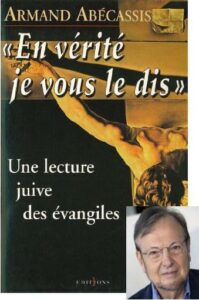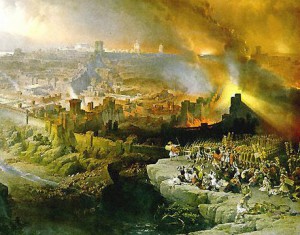3. The Incarnation of the two forms of the Torah, the Written Torah and the Oral Torah
Nanine Charbonnel stresses the Jewishness — the “Jewish rootedness” — of the interpretations that have been discussed in this series of posts. In the words (translated) of Jacqueline Genot-Bismuth,
The principle of the dissociation of the Message and the Messenger at work with Moses (Moses receives a text to be transcribed and transmitted: the “Law of Moses” is the Law or Torah written by the intermediary Moses) is substituted by a new logic of the combining of the Message and the Messenger: according to the teaching of Jesus written by John, God does not send a new revealed book, a new written text, but a revealed man-book, a revelation in act and not in writing, rather like having a materialization of that prophetic dream of Ezekiel [. . where the prophet ingests the megilah [scroll], thus making it his living substance, his … “flesh and blood”.
(Genot-Bismuth, Un homme nommé Salut, p. 222. My highlighting in all quotations)
Jesus is not the bearer of the new revelation; rather, he is himself, in person, the revelation. Jesus/Joshua means “Yahweh saves” and the Word of “Yahweh Saves” is the totality of the word of God in one’s being, life and acts.
We have seen that there is nothing novel about the idea of the incarnation, in some manner, of the Torah in Jewish thought. So what makes Christianity distinctive? The answer that NC offers is the incarnation of the two types of Torah, the written and the oral.
In Pharisaic Judaism great emphasis was placed on the inseparability of the Oral and Written Torah. For the Pharisees (we are going back into the BCE era) it was necessary for an Oral Torah to explain how to apply the Written code in concrete situations of everyday life. The Oral Torah was a way of maintaining the relevance of the Written Torah. The Oral Torah, it can be said, “manifests” or renders “visible” the Written law in daily life, making it a living code of conduct. In this way we find in rabbinic writings that every Jew was encouraged to become “a living Torah”. Indeed, when the Torah enters the flesh in Israel then the word of God finds its fulfilment. (Lorsque la Torah prend chair en Israël, elle accomplit le dynamisme de la Parole. — Massonnet, p. 286)
We have evidence that the relationship between Oral and Written Law was being debated in Palestine in the decades around the turn from BCE to CE. One example is a story of two sages from that era, Hillel and Shamai (only indirectly referenced by NC via Jean-Christophe Attias in Les Juifs et la Bible):
The Sages taught: There was an incident involving one gentile who came before Shammai. The gentile said to Shammai: How many Torahs do you have? He said to him: Two, the Written Torah and the Oral Torah. The gentile said to him: With regard to the Written Torah, I believe you, but with regard to the Oral Torah, I do not believe you. Convert me on condition that you will teach me only the Written Torah. Shammai scolded him and cast him out with reprimand. The same gentile came before Hillel, who converted him and began teaching him Torah. On the first day, he showed him the letters of the alphabet and said to him: Alef, bet, gimmel, dalet. The next day he reversed the order of the letters and told him that an alef is a tav and so on. The convert said to him: But yesterday you did not tell me that. Hillel said to him: You see that it is impossible to learn what is written without relying on an oral tradition. Didn’t you rely on me? Therefore, you should also rely on me with regard to the matter of the Oral Torah, and accept the interpretations that it contains.
Among these Jews the Oral Law was deemed to be a divine revelation that Israel alone had the privilege of receiving; the Written Law was said to be a sealed book to anyone who does not read it by the lights of the Oral Law; and the Oral and Written Law are not two Laws but one and the same law of which only Israel holds the key. (Attias, p. 140)
The Qumran library yields further evidence of discussion of these concepts. In the Damascus Document we read of an eschatological figure who appears to have prophetic and messianic traits, one called Interpreter of the Law, who :
The books of the Torah are equivalent to the booth of the king as it says, And “I will raise up the fallen booth of David” (Amos 9:11). The king refers to the <prince> of the congregation and the Kiyyun of their images are the books of the prophets whose words Israel has despised. The star is the Interpreter of the Torah who is to come to Damascus, as it is written, “A star has stepped forth from Jacob and a scepter has arisen from Israel” (Num 24:17).
(CD 7:15-20)
Some have interpreted this figure as one comparable to a new Moses who gives interpretations of Torah in his lifetime and again as an end-time Elijah who will return to teach righteousness.
Again from Qumran, the Commentary on Habakkuk 2:4
[But the righteous shall live by his faith] (2:4b).
…. Interpreted, this concerns all those who observe the Law in the House of Judah, whom God will deliver from the House of judgement because of their suffering and because of their faith in the Teacher of Righteousness. . . . (The words of the prophet are understood in terms of a qualified relationship to an exceptional person, the supreme guide of the “community” or Teacher of Righteousness (probably a fictitious figure).
(André Paul, Qumrân et les Esséniens, p. 102)
NC follows André Paul and others who view the Teacher of Righteousness as a personification of the pious study of Scriptures or Torah. The process followed is midrash, built upon new understandings emerging from interpretations of the Law. Such a process would make a strictly legalistic application of the Torah impossible, as we see in the example of Hillel who is reputed to have taught a merciful application of the Law.
 Personification … of Exegesis Itself?
Personification … of Exegesis Itself?
NC refers to the insights of the Jewish scholar Armand Abécassis who, while believing in a historical Jesus, ironically provides insights that offer every reason to understand Jesus was a midrashic fabrication. Abécassis explains that the Voice at the Revelation at Mount Sinai was needed to render God’s meaning in language in order to be understood. Moses was not the voice nor the language, otherwise he would be a prophet like any other. Instead, Moses is the mediator or link between the voice — he is neither the voice nor the message of the voice.
Contrast Jesus (continuing the exposition of Abécassis): As a divine figure he is necessarily beyond all human language and would himself be the voice itself. But he is also a human figure, and so he translates the divine voice into human language and meaning so that his message can be understood.
What would his listeners hear when they heard him speak?
Hebrews or Jews would strive through midrash to interpret his words and discover the infinite meaning behind them . . . . But Christians are asked to listen to the voice of Jesus itself: in this case his words would be absolute and would not allow for any interpretation.
Armand Abécassis thus sets up two approaches to meaning or interpretation of Jesus: that of Judaism which represents the capacity to grasp the necessity for interpretation of the full meanings behind the voice; that of gentile Christianity with its need to “divinize” the voice as an absolute and final word. NC points out that there is more to say here and that such a division is too simplistic. After all, probably all religions have their opposing divisions between “spiritual interpretation” and literalism. Once the semantic error of confusing the textual figure on “paper” for a historical person there will in fact be no end to various interpretations.
This is not the case, since we have at least four canonized Gospels that tell of singular encounters and particular understandings of the facts and sayings of Jesus.
But it could be said that the four Gospels are the four levels of rabbinic reading of the human word when it opens to the voice: the literal reading (Peshat), the allusive reading (Remaz), the interpretative reading (Derash) and the initiatory or spiritual reading (Sod). In this sense, Jesus is no longer the voice but the one who, like Moses, mediates between it and the word. But unlike Moses who is both prophet and legislator, Jesus is totally identified with interpretation and its dynamics.
And this obliges us to say what we have been silent about until now: Jesus is an internal matter for Judaism. But the Church has taken him out of it to offer him to the Gentiles. This could not be done in the first instance without the invention of Christianity: Jesus then became the Christ, the very voice that the Gentiles must believe.1
1. Let us say more clearly: Jesus identifies himself with the oral law. Moses gave the written Torah and the oral Torah.
(Abécassis pp. 335-36 – translated)
As NC points out, Abécassis never thinks of questioning the historical existence of Jesus but has provided here (see that note “1” above) “an astonishing tool for understanding that the character is entirely a midrashic fabrication”: “Jesus identifies himself with the Oral Law” whereas Moses is supposed to have given both the Written Torah and the Oral Torah”.
Let us put it another way: the character Jesus is perhaps not only the personification of the Written Torah, but also of the Oral Torah. Would this not be the supreme stage of hermeneutical invention: to make a character of “paper” (papyrus…), in written texts, the personification of the Oral Law, that is to say, of the interpretation of the written Law?
(Charbonnel, p. 351 – translated)
The acts of this fictional character instruct readers in the implementation of the oral Law. So, for example, when we read of Jesus healing on the sabbath day (John 5:8-9) we are accustomed to interpreting this episode as Christianity breaking away from Jewish legalism. In fact, however, Jesus’ miracle turns out to be the enactment of the commandment of the Oral Torah:
. . . saving a life overrides Shabbat . . .
(Yoma 86a)
 The episode of Jesus meeting the Samaritan woman at the well takes on a new meaning when we recall that the Samaritans rejected the oral law. Jesus is offering the complete package, one might say.
The episode of Jesus meeting the Samaritan woman at the well takes on a new meaning when we recall that the Samaritans rejected the oral law. Jesus is offering the complete package, one might say.
NC refers in a note to a work more familiar to English-language readers, The New Moses. A Matthean Typology by Dale C. Allison. I will quote some passages that tie in well with the identification of Jesus with Torah (my bolded highlighting):
(10) In 11:29b Matthew’s Jesus declares: “And learn of me because I am meek and lowly in heart.” Attention has already been called to the Mosaic background of meekness. Here notice needs to be directed to “learn of me.”
In Judaism one “learned” Torah. In the First Gospel one “learns” of and from Jesus—with the implication that Jesus is or takes the place of Torah—an idea certainly found elsewhere in early Christianity, including Paul, John, and Hermes (Sim. 8:3.2: the law is the Son of God). One takes up the yoke of Jesus and one studies him. Thus he is “all that God has made known of his nature, character, and purpose, and of what he would have man be and do.”
. . . . Jesus embodies his utterance. He therefore is, as Lactantus put it, a “law alive” (Div. inst. 4:17; cf. already Justin, Dial. 11: the eternal law is Christ).
. . . .
. . . . in Judaism, Wisdom and Torah were intimately joined, indeed “fundamentally interchangeable.” The evidence has been set out often enough, and I need not review it again here. Suffice it to refer to Ecclus. 24:23-24; Wisd. 6:18; Bar. 3:28-4:4; and 4 Macc. 1:16-17 (cf. also Deut. 4:6). These representative passages demonstrate that the identification of Wisdom with Torah was a first-century commonplace. What follows? Because Wisdom and Torah were one, Matthew’s equation of Jesus with Wisdom bolsters my argument that the evangelist also identified Jesus with Torah.
Now what does all this have to do with Moses? Under Persian influence, the Graeco-Roman world was quite familiar with the idea of the king as a living law:
Now laws are of two kinds, the animate [empsychos] law, which is the king, and the inanimate, the written law (Pseudo-Archytas of Tarentum, in Stobaeus 4:1.132).
The king is animate law [nomos empsychos], or is a legal ruler. So for this reason he is most just and most lawful (Diotogenes in Stobaeus 4:7.61).
In general the good king must be sinless and perfect in word and deed; since he must be what the ancients call animate law, creating a law-abiding spirit and unanimity, and thrusting out lawlessness and strife (Musonius, in Stobaeus 4:7.67).
Moreover, Hellenistic Jews, persuaded that Moses was a king who lived his own words …, and stimulated by the use of “Moses” as a designation for the Pentateuch, made Moses the living Torah: “Moses and the law were more or less identified and the concept and the name were de facto frequently inter- changeable.” As Philo wrote: Moses was “the reasonable and living impersonation of law” (nomos empsychos; Mos. 1:162; cf. 2:3-5; Clement of Alexandria, Strom. 1:29). But, as we have seen, that is precisely what Matthew’s Jesus is—the “living impersonation of law.” Once more, therefore. Matt. 11:25-30 leads us back to the first lawgiver.
(Allison, 228-30)
 Wisdom is identified with the Law, as is one named “Yahweh Saves” (Jesus). Now most sense is made of all of this if the Temple itself has been demolished and the Mosaic cult has been obliterated — as happened in 70 CE. Recall the words of Daniel Boyarin, quoted earlier,
Wisdom is identified with the Law, as is one named “Yahweh Saves” (Jesus). Now most sense is made of all of this if the Temple itself has been demolished and the Mosaic cult has been obliterated — as happened in 70 CE. Recall the words of Daniel Boyarin, quoted earlier,
Not even the appearance of the Logos as human, I would suggest, but rather the ascription of actual physical death and resurrection to the Logos was the point at which non-Christian Jews would have begun to part company theologically with those Christians . . . .
(Boyarin, 125)
Others pushed for a variant identification: the Word and Lamb. In Aramaic the two words are homophones. Add the account of Israel’s catastrophe and we emerge with the Passion of the Messiah.
–o0o–
To be continued…..
 Abécassis, Armand. “En vérité je vous le dis”: Une lecture juive des évangiles. Paris: NUMERO UN, 1999.
Abécassis, Armand. “En vérité je vous le dis”: Une lecture juive des évangiles. Paris: NUMERO UN, 1999.
Allison, Dale C. The New Moses: A Matthean Typology. Minneapolis, MN: Fortress Press, 1993.
Attias, Jean-Christophe. Les Juifs et la Bible. Paris: Fayard, 2012.
Boyarin, Daniel. Border Lines: The Partition of Judaeo-Christianity. Philadelphia, Pa.: University of Pennsylvania Press, 2006.
Charbonnel, Nanine. Jésus-Christ, Sublime Figure de Papier. Paris: Berg International éditeurs, 2017.
Genot-Bismuth, Jacqueline. Un homme nommé Salut. Genèse d’une hérésie à Jérusalem. François-Xavier De Guibert édition. Paris: Francois-Xavier de Guibert, 1995.
Massonnet, Jean. Aux Sources Du Christianisme: La Notion Pharisienne De Révélation. Bruxelles: Lessius, 2013.
Paul, Andre. Qumrân et les Esséniens. Paris: Lexio, 2016.
If you enjoyed this post, please consider donating to Vridar. Thanks!

If Boyarin is right about the point of departure between Jews & Christians (last par.), this helps to confirm the nature of the tendency of Jews to see Jesus as a figure (of paper?) essentially contending with others over the nature of rabbinic wisdom, rather than as a salvific god. In Judaism, Jesus would be a figure designed to heal the rift between oral and written tradition, a unifying law personified. The problem with non-Gnostic Christianity has always been the tendency toward simplistic literalizations of everything. According to this scheme above, Christianity appears as a kind of dumbed-down Judaism.
Yes, that is the message I thought I was reading in some of the French passages but I did not spell it out clearly in the post because I still need time to get my head around certain expressions that don’t translate easily into English. Meanwhile, I can leave anyone interested with this final section of Abecassis’s chapter from which I did quote:
Which DeepL renders easily enough as
Thanks to a kind soul getting in touch, I have updated the above post with some typo corrections and making up for an oversight in the bibliography. If you notice any more errors please do let me know.